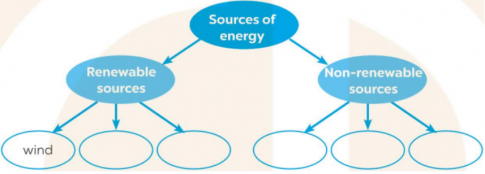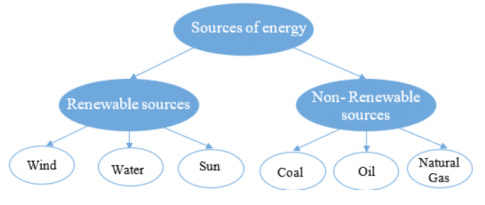Complete the chart. Then ask and answer the questions about advantages and disadvantages of renewable and non-renewable sources. (Hoàn thành biểu đồ. Sau đó hỏi và trả lời các câu hỏi về ưu nhược điểm của các nguồn tái tạo và không tái tạo.)
3. Complete the chart. Then ask and answer the questions about advantages and disadvantages of renewable and non-renewable sources. (Hoàn thành biểu đồ. Sau đó hỏi và trả lời các câu hỏi về ưu nhược điểm của các nguồn tái tạo và không tái tạo.)

Example:
A: What type of source is solar energy?
B: It’s a renewable source.
A: What are its advantages?
B: It’s available and clean to use.
A: What are its disadvantages?
B: It doesn’t work on cloudy days or at night.
**
A: What type of source is coal?
B: It’s a non- renewable source.
A: What are its advantages?
B: It’s rather cheap and we can find it in lots of places.
A: What are its disadvantages?
B: When we burn coal, it causes pollution.

A: What type of source is water?
(Nước thuộc loại năng lượng nào?)
B: It’s a renewable source.
(Nó là năng lượng có thể tái tạo.)
A: What are its advantages?
(Ưu điểm của nó là gì?)
B: It’s abundant and it has low emissions.
(Nó dồi dào và có lượng khí thải thấp.)
A: What are its disadvantages?
(Nhược điểm của nó là gì?)
B: It’s expensive to build and it may cause drought.
(Việc xây dựng tốn kém và có thể gây ra hạn hán.)
***
A: What type of source is natural gas?
(Khí tự nhiên thuộc loại năng lượng nào?)
B: It’s a non-renewable source.
(Nó là năng lượng không thể tái tạo.)
A: What are its advantages?
(Ưu điểm của nó là gì?)
B: It’s abundant and easily transported.
(Nó dồi dào và dễ dàng vận chuyển.)
A: What are its disadvantages?
(Nhược điểm của nó là gì?)
B: It pollutes the environment and it can be difficult to harness.
(Nó gây ô nhiễm môi trường và có thể khó khai thác.)

Bình luận